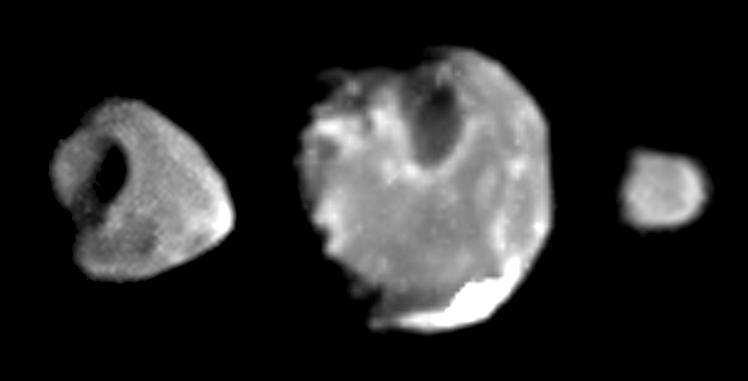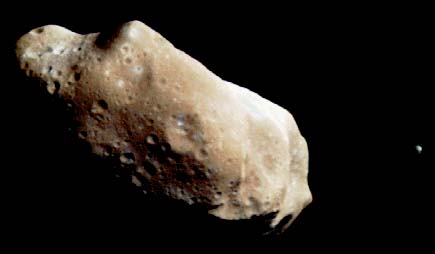Everyone knows you shouldn’t eat green potatoes, but what about red potatoes (no, this doesn’t include potatoes with red skins)? I’m not sure on that count, but this red potato would likely taste like, well, rock and a whole lot of radiation courtesy of its parent planet, Jupiter. When I say this moon is red, it’s red, considered as the reddest object in our solar system. It is a moon that is not much more than a pile of icy rubble with a very low density. The most significant feature on its surface is a couple of craters, named Gaea and Pan, discovered and imaged by the Galileo space-craft in the 1990s. Pan is the larger of the two craters, with a diameter of 100km and a depth of up to 8km. In contrast, Gaea is a crater measuring around 80km across with a depth of up to 12km.

Amalthea is the biggest of the four moons that orbit within the moon Io’s orbit; the other three are Adrastea, Metis and Thebe. Of them all, Amalthea orbits the closest to Jupiter at an average distance of 181,400 kilometres away from the gas giant’s surface. It orbits Jupiter at an average speed of 95,362km/hr, taking just under half an Earth day to complete one revolution. Considering Jupiter’s enormous gravitational pull, it seems odd that this ruddy moon has not been torn apart to this day. It’s pretty simple: its dinky size means that tidal pull from Jupiter’s gravity has minimal influence on Amalthea, so it can carry on merrily orbiting the gas giant behemoth. Nevertheless, with time, it will eventually meet its demise when its orbit decays to the point that it will fall toward Jupiter and be torn apart forever.

On a final note, you might think that, because it is so close to its parent planet, it would have been impossible for anyone to spot it before Voyager 1 flew past it in 1979. To the contrary! In fact, this modest little moon was discovered in 1892 by Edward Emerson Barnard, who spotted it through his 91 cm refractory telescope while he was working at the California-based Lick Observatory, which at the time, was only four years old (built in 1888.) It might be a tiny moon of little note in most mainstream astronomy textbooks and books in general, but it has been known since horse-and-carts were still in vogue.
To round off this post, enjoy a beautiful image of Amalthea casting its shadow on Jupiter as imaged by the JUNO space-craft currently (as of 2021) in orbit around the gas giant.

References:
“Amalthea Casts Shadow on Jupiter. (October 2017. Sci-news website.)
“Juno Completes its Eighth Flyby of Jupiter.” (September 2017. Sci-news website.)
“Amalthea” (Solar Views website)
Lick Observatory (Links to “About” Page)
In Depth: Amalthea. (NASA website)
By the Numbers: Amalthea (NASA website)
“SOLAR SYSTEM: Jupiter, Saturn, and Their Moons” (2005). Moore, P. In: Encyclopedia of Geology (pp. 282-289).







You must be logged in to post a comment.